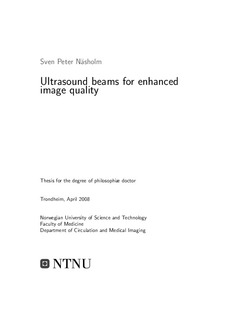| dc.contributor.advisor | Angelsen, Bjørn A.J. | nb_NO |
| dc.contributor.author | Näsholm, Sven Peter | nb_NO |
| dc.date.accessioned | 2014-12-19T14:16:38Z | |
| dc.date.available | 2014-12-19T14:16:38Z | |
| dc.date.created | 2008-05-07 | nb_NO |
| dc.date.issued | 2008 | nb_NO |
| dc.identifier | 124308 | nb_NO |
| dc.identifier.isbn | 978-82-471-9144-6 | nb_NO |
| dc.identifier.uri | http://hdl.handle.net/11250/263112 | |
| dc.description.abstract | The contents of this thesis consider new methods for generating ultrasound beams for enhanced image quality in medical imaging. The results presented are produced through computer simulations. The thesis consists of an introductory chapter and four papers, which are all intended to be individually readable.
Chapter 1 gives a brief overview of ultrasound and medical ultrasound imaging, as well as different aspects of ultrasound image quality and acoustic noise. A non-linear wave equation is presented and analyzed. This equation describes ultrasound propagation within, and interaction with tissue.
In Paper A, a transducer annular array design method is presented. The method involves a geometric pre-focusing, which may vary between the array elements. This is useful for producing narrow receive beams within a large imaging depth window. It is advantageous for avoiding problems that occur when combining high frequencies and large receive apertures when utilizing the conventional equal-area design method.
Paper B introduces a method to produce synthetic transmit beams that are useful for suppression of reverberation noise caused by multiple scattering of the forward-propagating imaging pulse. This is done through combination of two transmit pulse complexes denoted Second order UltRasound Field (SURF). Each such complex consists of a conventional high-frequency imaging pulse added to a low-frequency sound-speed manipulation pulse. The SURF transmit beam is generated by forming the difference between the propagated fields, filtered around the imaging frequency. This beam has suppressed amplitude near the transducer, where a reflection-generating body-wall is often present during in vivo imaging. Furthermore, a method to produce a combined second-harmonic pulse inversion (PI) and SURF beam is also presented, here denoted SURF-PI. Two imaging setups are defined for which the feasibility of the method is tested through simulations in case of propagation through homogeneous tissue. SURF beams and combined SURF-PI beams are compared to fundamental imaging and PI imaging beams for the two setups. The SURF-PI beams are the most suppressed in the near-field, followed by the approximately equally suppressed SURF and PI beams. The signal level within the imaging depth region becomes higher for SURF than for PI.
In Paper C, two signal processing methods for further adjustment of the SURF beams are introduced. This is achieved through post-processing, either by application of a time-shift, or of a general filter, to one of the propagated fields. The processing is done prior to carrying out the subtraction that is done to form the SURF beam. This provides a flexible way of adjustment to choose the depth position where the scattering sources wished to be suppressed are located. Different adjustments may be realized without need for re-transmission or resumed propagation of the SURF pulse complexes. The post-processing methods are applied to a dataset generated for Paper B. Adjusted transmit beam examples are presented and their reverberation suppression abilities are compared to non-adjusted SURF.
In Paper D, the feasibility study of the SURF beam generation as presented in Paper B, and its post-processing adjustment as presented in Paper C, are enlarged to include propagation within an inhomogeneous medium where a body-wall model producing severe aberration delays is present. It is shown that both the generation of the SURF beams and the post-processing adjustment are attainable under the modeled conditions. | nb_NO |
| dc.language | eng | nb_NO |
| dc.publisher | Det medisinske fakultet | nb_NO |
| dc.relation.ispartofseries | Dissertations at the Faculty of Medicine, 0805-7680; 2008-152 | nb_NO |
| dc.relation.haspart | Näsholm, Sven Peter; Hansen, Rune; Måsøy, Svein-Erik; Johansen, Tonni F.; Angelsen, Bjørn A.J.. Transmit beams adapted to multiple scattering noise suppression using SURF dual-frequency imaging. . | nb_NO |
| dc.relation.haspart | Näsholm, Sven Peter; Hansen, Rune; Angelsen, Bjørn A.J.. Post-processing adjustment of the SURF reverberation noise suppression depth. . | nb_NO |
| dc.relation.haspart | Näsholm, Sven Peter; Angelsen, Bjørn A.J.. SURF reverberation suppression transmit beam generation and post-processing adjustment within an aberrating medium. . | nb_NO |
| dc.subject | TECHNOLOGY: Other technology: Medical engineering | en_GB |
| dc.title | Ultrasound beams for enhanced image quality | nb_NO |
| dc.title.alternative | Ultralydstråler for forbedret bildekvalitet | nb_NO |
| dc.type | Doctoral thesis | nb_NO |
| dc.source.pagenumber | 133 | nb_NO |
| dc.contributor.department | Norges teknisk-naturvitenskapelige universitet, Det medisinske fakultet | nb_NO |
| dc.description.degree | PhD i medisinsk teknologi | nb_NO |
| dc.description.degree | PhD in Medical Technology | en_GB |
